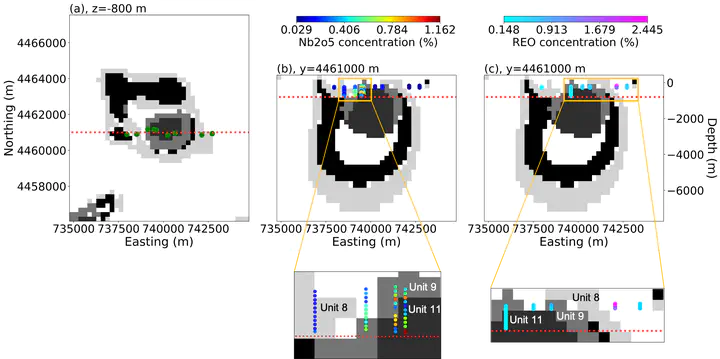A critical mineral exploration – Niobium

Figure Caption
Spatial distribution of identified geological Unit 7, 8, 9 and 11 with drillhole locations as well as assay measurements. (a) is a depth slice at the elevation of -800-m in where the green dots indicate locations of drillholes, (b) and (c) are vertical cross-sections of 4461000-m. The colored dots in (b) and (c) represent, respectively, the percent concentrations of Nb2o5 and REO (rare earth oxides).
Project Summary
Mineral is essential in our daily life ranging from the talc in makeups, calcite in toothpastes, nickel in batteries to silicon in integrated circuit. The demands of minerals have been steeply increasing for decades, as the global energy portfolio shifts from fossil fuels to renewable energy sources (also known as energy transition), such as electronic vehicles, wind turbines and solar panels. Niobium is one of the 50 critical minerals identified by the US Department of Interior in 2022, which shows great potential in lithium-ion batteries to increase the energy storage, directly influencing the performance of electric vehicles.
We present a case study on using airborne geophysical data, borehole and physical property measurements to characterize the Elk Creek Carbonatite complex located in the southeast of Nebraska, US. It hosts the largest known niobium deposit in the United States. Our quasi-geology model shows remarkable consistency with the assay measurements and coincides with the known niobium deposit. We also discover a significant volume of potential target body directly underneath the known niobium ore zone. Our work demonstrates the effectiveness of integrated geophysical imaging and geology differentiation for the critical mineral exploration.